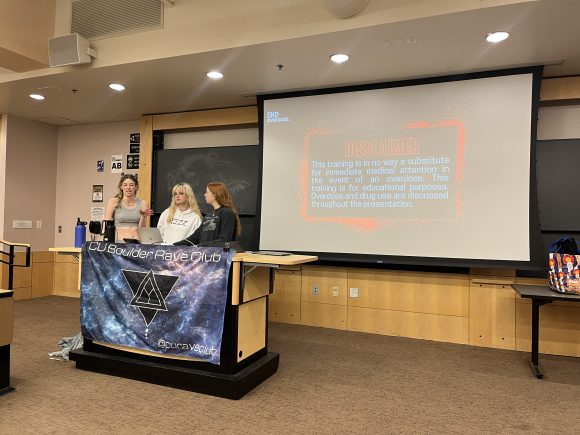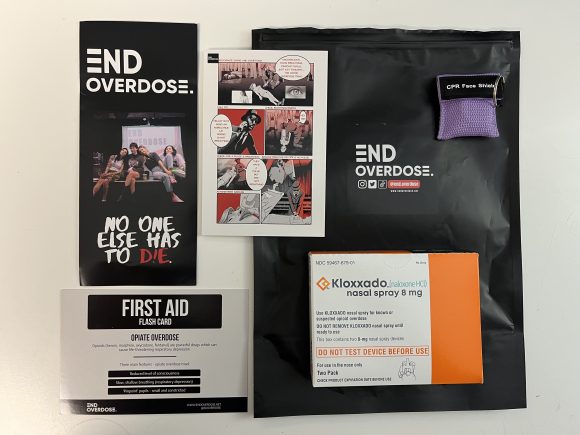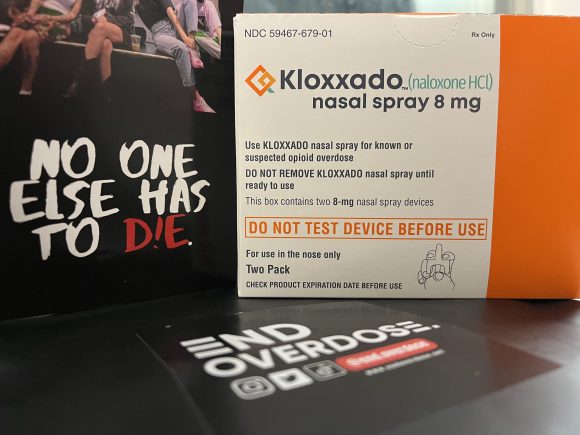
End Overdose Boulder is a local branch of the national organization, led by three CU Boulder students. (Feb. 28, 2023) (Emi Ambory/CU Independent)
Over the past week, there has been a growing concern about opioid overdoses in the Boulder community. This is largely in response to the Boulder Police Department’s (BPD) reports of an increase in what they suspect to be fentanyl related overdoses the week of April 10.
BPD responded to five suspected overdoses in 36 hours, which they described as an “unusually high number of overdoses” in a tweet posted on April 12. The police warned community members that there could be a new type or “tainted strain” of fentanyl on the streets.
Fentanyl is a synthetic opioid painkiller that is 50 times stronger than heroin and 100 times stronger than morphine, according to the Centers for Disease Control and Prevention. The drug is administered in medical setting to treat pain. Recreationally, and often unbeknownst to the user, fentanyl is used to lace other illegal drugs, such as cocaine, counterfeit Xanax and counterfeit Adderall, due to its addictive properties.
According to End Overdose, a national nonprofit that seeks to end drug-related overdose deaths through education, medical intervention and public awareness, the fentanyl contributing to an increase in opioid overdoses is illicitly manufactured, highly addictive and extremely lethal due to its potency.
End Overdose hosts trainings throughout the country with information on how to respond if someone has overdosed. The organization recommends contacting medical professionals as quickly as possible in the event of an overdose.
Sophie Kennedy, Halle Francis and Grace Naysmith started an End Overdose chapter in Boulder last semester to address the rise in fatal overdoses in young people caused by fentanyl.
In addition to leading educational training, End Overdose also provides students with harm reduction kits that contain fentanyl testing strips, nasal spray naloxone and informational pamphlets. Naloxone, also known by its brand name Narcan, is a medication that can reverse an opioid overdose.

The contents of an End Overdose harm reduction kit. (April 19, 2023) (Emi Ambory/CU Independent)
In the event of an overdose
The leaders of Boulder’s End Overdose chapter recommend the following steps in the event of a suspected overdose.
Recognize the signs and symptoms
A person who is experiencing an overdose may be unconscious, have slowed or stopped breathing and have unresponsive pupils, meaning the dark center of their eye is smaller than normal and doesn’t react to light.
“If you don’t know if someone is just too drunk or if they’re overdosing, the biggest [sign] is going to be pinpoint pupils,” Francis said. “If you shine a light in someone’s eyes and their pupils don’t respond, you should [administer Narcan].”
Call 911 and yell for help
Call 911 in the event of an overdose. At a concert or festival, paramedic tents will often be available to administer medical assistance.
Colorado’s Good Samaritan Law can grant immunity from arrest and prosecution if someone administers naloxone or contacts 911, law enforcement or a medical provider to help someone experiencing an overdose.
The Colorado legislature passed a bill in April that would extend this immunity to anyone who helped the person suffering from an overdose, even if they didn’t report the situation to an emergency responder.
Given that naloxone wears off after 30 to 90 minutes, it’s important to get professional medical attention as soon as possible before the person slips back into an overdose.
“Make sure the person gets medical attention to protect you and to protect them,” Kennedy said.
Check for responsiveness
To check for responsiveness, shout the person’s name, tap their foot and administer a sternal rub.
“[To administer a sternal rub], take your knuckles and rub them on someone’s ribs,” Kennedy said. “It’s definitely not a pleasant feeling, and it will wake someone up if they’re not breathing.”
Checking for responsiveness is very important. If someone isn’t experiencing an opioid overdose but is on other drugs, administering Narcan can send them into withdrawal. This will not have life-threatening consequences, but it will be very uncomfortable and potentially painful for this person.
Check for breathing and the presence of a pulse
It’s important to check the person’s breathing and pulse continuously. According to End Overdose, an adult normally breathes 12 to 20 times per minute.
If the person’s breathing and pulse are irregular, they aren’t responsive and are displaying other symptoms of an overdose, administer naloxone.
Administer naloxone to restore breathing
To administer naloxone, lay the person on their back and peel the packaging off of the spray. Place the elongated front portion of the device in one nostril and push the plunger, located between the two bars on either side of the spray, all the way in.
“It’s just like allergy relief spray,” Francis said.
If the person’s breathing has not returned to its normal rate within two to three minutes, administer another dose. This second dose should be administered in the other nostril. Stay in contact with emergency services during this process for guidance and advice.
Continue to provide care
While waiting for medical assistance, continue care by performing rescue breaths.
To administer rescue breaths, first look and listen to the person’s chest to check if they’re breathing. Then, while they are still lying flat, tilt their chin up to adjust their airway. Then, form a seal and exhale. Administer one breath every five seconds. If there are concerns about mouth-to-mouth breathing, use a mouth-breathing mask, which is included in End Overdose’s kits.

A package with naloxone next to End Overdose flyers. (April 19, 2023) (Emi Ambory/CU Independent)
Preventative measures
There are several steps that community members can take to help prevent an overdose from occurring.
Test drugs beforehand
Most drugs can be tested for fentanyl with testing strips. During this process, it’s important to get the most even sample possible.
End Overdose offers testing strips when they table on campus, and the Collegiate Recovery Community provides strips on the fourth floor of the University Memorial Center in Room 414.
Only a small amount of powder is needed for a sample, such as the residue left on the inside of a drug’s container.
Drugs like MDMA, crack cocaine and methamphetamine can be tested by crushing them up in their bag to make it easier to dissolve the sample in water. Pills like Adderall, Vyvanse and OxyContin can also be tested in a similar way; however, each pill should be scraped laterally to get the most consistent sample of the pill possible.
Remember to test each individual pill. Powders, such as cocaine, heroin and ketamine, are tested in a similar way. When testing these drugs, be sure to collect the sample from one corner of the bag, as other parts of the sample could contain fentanyl.
“For rocks and powders, what you can do…is take your dime bag full of drugs and transfer it into another container,” Kennedy said. “Then you’ll have residue on the original bag, so you can just fill that bag with water and test directly in there. There’s really no excuse not to test your drugs.”
How to use a fentanyl testing strip
First, fill a small container with at least 15 milligrams of water, which is equivalent to a tablespoon or a bottle of nail polish.
“Anything that’s [able to be dissolved in water] can be used to test fentanyl,” Francis said.
Next, fully dissolve a small amount of powder, or the residue from your dime bag, into the water.
Hold the blue, wavy end of the testing strip in the water for 10 seconds.
“[The waves] look like water, so it’s pretty easy to remember,” Francis said.
Finally, take the strip out of the water, lay it flat and wait for 60 seconds.
In End Overdose’s harm reduction kits, there is a QR code that links to an instructional video reviewing how to use fentanyl testing strips.
How to interpret the test results
If there is one red line present, the test is positive, and there is fentanyl present in the sample. If there are two red lines, the test is negative, and there is no fentanyl present in the sample.
“If it tests positive, it means one or two of two things: either [the sample] contains fentanyl, or it’s a false positive,” Francis said. “With molly, stimulants like Adderall or amphetamines, you can get a false positive. What we recommend you do is to just double the amount of water that you originally used and retest.”
“If you do decide to take the drugs that tested positive, just make sure you tell a friend and have naloxone on you in case you have to respond if there is fentanyl in there,” Naysmith said.
The organizers said that testing drugs has helped other students in the past.
“Most people get their drugs from the same person,” Francis said. “This actually happened the week of [a concert]. We had four or five people that reached out to us and let us know that they had drugs that tested positive, so we were able to set up an extra table [to offer overdose prevention kits].”
For community members who have drugs that have tested positive for fentanyl, End Overdose asks them to send a direct message on Instagram at @endoverdose.boulder. They will then anonymously share this report to let others know that there are fentanyl-laced drugs in Boulder. They can also be contacted on Instagram to request a free kit.
Naloxone is also available on the third floor of the Wardenburg Health Center.
Contact CU Independent Staff Writer Emi Ambory at emily.ambory@colorado.edu.
